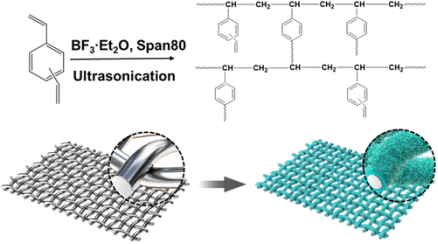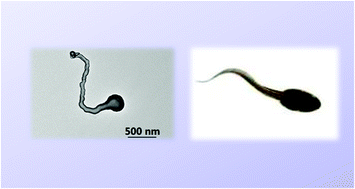1. Xu, Wei; Xiang, Dao; Xu, Jingjing; Ye, Yilan; Qiu, Dong; Yang, Zhenzhong*, Facile Intramolecular Crosslinking of Polymers by Metallic Coordination in Concentrated Solutions, Polymer Chemistry, 2021,12(2): 172-176.
A facile approach is proposed toward metal-containing single-chain composite nanoparticles by intramolecular crosslinking in concentrated solutions at ambient temperature. Both introducing electrostatic repulsion and crosslinking by coordination with metal ions are fast and performed under mild conditions. The functional nanoparticles are promising as artificial enzymes.

2. Xu, Jingjing; Xu, Wei; Sun, Dayin; Xiao, Haihua; Yang, Zhenzhong*, The Stepwise Organization of Nanoparticles into a Pickering Emulsion, Soft Matter, 2021, 17(7): 1796-1801.
Core/shell PVSt-b-PS@Fe3O4 composite nanoparticles (NPs) are achieved by grafting living cationic block copolymer chains onto the surface of amine-capped Fe3O4 NPs via fast termination. The number of chains grafted can be tuned via the molecular weight of PVSt-b-PS. Upon grafting PEG onto the PVSt block via a click reaction, the resulting (PVSt-g-PEG)-b-PS@Fe3O4 composite NPs become highly dispersible in water. A composite nanoparticle with ten chains is selected as a homogeneous NP to demonstrate the dynamic stepwise organization of the NP as oil is fed into the aqueous dispersion. The individual NPs with captured oil are further aggregated, but remain stable with increasing oil content. Eventually, a Pickering emulsion forms in which the aggregates are anchored at the emulsion interface. This dynamic behavior study helps to provide an understanding of the mechanism by which NPs stabilize Pickering emulsions.

3. Wang, Chunyu; Shao, Yue; Zhang, Kunfeng; Wu, Baichun; Du, Xianyuan; Li, Xingchun; Zhang, Xiaoyan; Liang, Fuxin; Yang, Zhenzhong*, Facile Approach to Fabricate a High-Performance Superhydrophobic Mesh, ACS Applied Materials & Interfaces, 2021, 13(13): 15720-15726.
When superhydrophobic meshes are used for oil/water separation, high flux and high intrusion pressure are usually compromised. Herein, a high-performance superhydrophobic stainless steel mesh membrane with a hairy-like poly(divinylbenzene) (PDVB) coating is fabricated by precipitated cationic polymerization. The synthesis is facile, which is completed in one step at ambient temperature within a short time, i.e., less than 90 s. The unique hair-like microstructure of PDVB is responsible for the superhydrophobic performance with less blockage for the pores. A higher flux for oil is achieved while keeping a high intrusion pressure. Especially, the ellipsoidal pore texture with two sharp tips can give additional high intrusion pressure. In the case of 2800 mesh, the superhydrophobic mesh displays an unprecedentedly high value of up to 22 kPa while maintaining a high flux of 2.0 x 10(4) L.m(-2).h(-1). The high intrusion pressure enables further increment of flux to 4.2 x 10(4) L.m(-2).h(-1) under a reduced pressure at a higher loading. The current high-performance superhydrophobic mesh realizes higher efficiency in separating oil/water mixtures, which is promising for practical applications, for example, in industrial extraction.

4. Wen, Wei; Guan, Song; Yang, Zhenzhong*; Chen, Aihua, Inverse Bicontinuous Structure by Polymerization-Induced Self-Assembly Against Single-Chain Nanoparticles, ACS Macroletters, 2021, 10(5): 603-608.
Polymer particles with inverse bicontinuous structures have attracted considerable attention due to their diverse applications. The conventional generation requires controlling numerous key parameters under strict conditions, such as solvent property, polymer composition, and architecture. In order to improve the preparation efficiency within a broad window, we employed a method by polymerization-induced self-assembly (PISA) against intramolecularly folded single-chain nanoparticles (SCNPs). The SCNPs bear an active site for further polymerization. The SCNPs with smaller sizes facilitate easier controlling of the packing parameter above unity to meet the requirement of the unique structures. The concept is demonstrated by forming the inverse bicontinuous structure through PISA in ethanol against two SCNPs of P4VP(SCNPx%)(35)-CTA and P(PEGMA(20)-co-TMSPMA(4))(SCNP16.7%)-CTA. The unique structure is easily achieved when growing a relatively shorter polymer chain within a broad window. The work paves the avenue to prepare polymer particles with the unique structure in large scale, and other functional materials are expected by using the functional SCNPs or favorable growth of desired materials within the particles.

5. Zuo, Xiuyuan; Zhang, Meng; Wu, Qiuhua; Li, Yuanyuan; Zhang, Guolin; Liang, Fuxin; Yang, Zhenzhong*, Tadpole-like Janus nanotubes, Chemical Communications, 57(47): 5834-5837.
Tadpole-like Janus nanotubes with controlled size are fabricated by a sol-gel reaction at the emulsion interface. Pd or Fe3O4 nanoparticles can be selectively captured into their cavities to obtain tadpole-like Janus Pd-nanotubes or tadpole-like Janus Fe3O4-nanotubes. They can be driven directionally by a chemical fuel or near-infrared (NIR) light.
